Two new interesting papers concerning Corded Ware and Bell Beaker peoples appeared last week, supporting yet again what is already well-known since 2015 about West Uralic and North-West Indo-European speakers and their expansion.
Below are relevant excerpts (emphasis mine) and comments.
#UPDATE (27 OCT 2019): I have updated Y-DNA and mtDNA maps of Corded Ware, Bell Beaker, EBA, MBA, and LBA migrations. I have also updated PCA plots, which now include the newly reported samples and those from the Tollense valley, and I have tried some qpAdm models (see below).
I. Corded Ware and Battle Axe cultures
Open access The genomic ancestry of the Scandinavian Battle Axe Culture people and their relation to the broader Corded Ware horizon, by Malmström, Günther, et al. Philos. Trans. R. Soc. (2019).
I.1. Origins of Corded Ware peoples
The discovery of the Alexandria outlier represented a clear support for a long-lasting genomic difference between the two distinct cultural groups, Yamnaya and Corded Ware, already visible in an opposition Khvalynsk vs. late Sredni Stog ca. 4000 BC, i.e. well before the formation of both Late Eneolithic/Early Bronze Age groups.
However, the realization that it may not have been an Eneolithic individual, but rather a (Middle?) Bronze Age one, suggests that Sredni Stog was possibly not directly related to Corded Ware, and a potential direct connection with Yamnaya might have to be reevaluated, e.g. through the Carpathian Basin, as Anthony (2017) proposed.
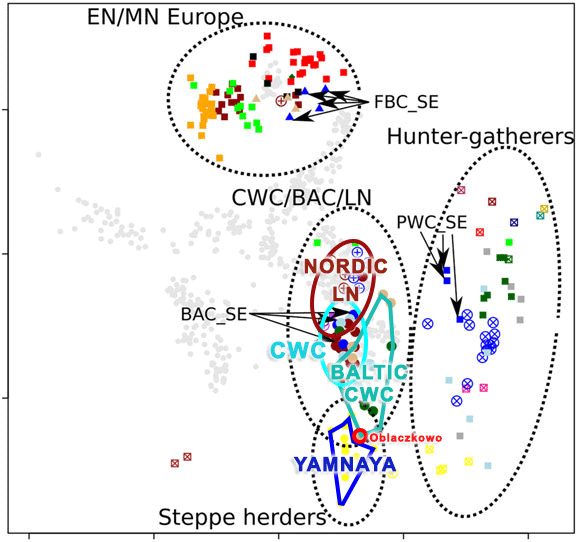
This new paper shows two early Corded Ware individuals from Obłaczkowo, Poland (ca. 2900-2600 BC) – hence close to the supposed original Proto-Corded Ware community – with an apparently (almost) full “Steppe-like” ancestry, clustering (almost) with Yamnaya individuals:
Similar to the BAC individuals, the newly sequenced individuals from the present-day Karlova in Estonia and Obłaczkowo in Poland appear to have strong genetic affinities to other individuals from BAC and CWC contexts across the Baltic Sea region. Some individuals from CWC contexts, including the two from Obłaczkowo, cluster closely with the potential source population of steppe-related ancestry, the Yamnaya herders. Notably, these individuals appear to be those with the earliest radiocarbon dates among all genetically investigated individuals from CWC contexts. Overall, for CWC-associated individuals, there is a clear trend of decreasing affinity to Yamnaya herders with time.
NOTE. Interestingly, this sample is almost certainly attributed to the skeleton E8-A, which had been supposedly already investigated by the Copenhagen group as the RISE1 sample:
We note that RISE1 is also described as the individual from Obłaczkowo feature E8-A. However, their genetic results differ from ours. They present this individual as a molecularly determined male that belongs to Y-chromosomal haplogroup (hg) R1b and to mtDNA hg K1b1a1 while our results show this individual to be female, carrying a mtDNA hg U3a’c profile
Since the typical Steppe_MLBA ancestry of Corded Ware groups does not show good fits for (Pre-)Yamnaya-derived ancestry, it is almost certain that these individuals will show no (or almost no) direct Yamnaya-related contribution, but rather a contribution of East European sub-Neolithic groups, more or less close to the steppe-forest region.
NOTE. They might show contributions from Pre-Yamnaya-influenced Sredni Stog, though, but if they show a contribution of Yamnaya, then they are probably outliers, related to Yamnaya vanguard groups (see image below). And for them to show it, then both sources, Yamnaya and Corded Ware, should be clearly distinguishable from each other and their relative contribution quantifiable in formal stats, something difficult (if not impossible) to ascertain today.

Their position in the published PCA – a plot apparently affected by projection bias – suggests a cluster in common with early Baltic samples, which are known to show contributions from East European sub-Neolithic populations (see qpAdm values for Baltic CWC samples).
NOTE. Results for previous samples labelled as Poland CWC are unreliable due to their low coverage.
The most interesting aspect about the ancestry shown by these early samples is their further support for an origin of the culture different than Sredni Stog, and for a rejection of the Alexandria outlier as ancestral to them, hence for a Volhynian-Podolian homeland of Proto-Corded Ware peoples, with an ancestry probably more closely related to the late Maykop Steppe- and Trypillian/GAC groups admixed with sub-Neolithic populations of the Eastern European Late Eneolithic.
NOTE. That is, unless there is a reason for the apparent increase in so-called “Steppe-ancestry” during the northward and westward migration of CWC peoples that represents another thing entirely…
#UPDATE (27 OCT 2019): Apparently, the PCA was actually not affected by projection bias:
Sample poz44 clusters ‘to the south’, with other early German ones, but also close to Yamnaya. Its poor coverage makes qpAdm results unreliable, but its common cluster close to central European and eastern CWC groups – despite belonging to the same Obłaczkowo site – supports that it is more representative of the Proto-CWC population than poz81.
Sample poz81 clusters with Yamnaya samples – or at least with the wider, Steppe-related cluster. Nevertheless, analyses with qpAdm – in combination with values obtained for other early Baltic samples – support that the ancestry of poz81 is more closely related to a core Corded Ware population admixed with sub-Neolithic peoples (similar to Samara LN).
NOTE. I have selected Czech CWC as a potential source closer to the Proto-CWC population, similar to models with Baltic samples. Since Czech CWC samples are later than these from Obłaczkowo, I have also checked the reverse model, with Poz81 and GAC Poland as a source for Czech CWC, and the fits are slightly worse. Anyway, ‘better’ or ‘worse’ p-values can’t determine the direction of migration…

I.2. CWC expansion under R1a bottlenecks
The two males in our dataset (ber1 and poz81) belonged to Y-chromosome R1a haplogroups, as do the majority of males (16/24) from the previously published CWC contexts, while a smaller fraction belonged to R1b [3/24] or I2a [3/24] lineages. The R1a haplogroup has not been found among Neolithic farmer populations nor in hunter–gatherer groups in central and western Europe, but it has been reported from eastern European hunter–gatherers and Eneolithic groups. Individuals from the Pontic–Caspian steppe, associated with the Yamnaya Culture, carry mostly R1b and not R1a haplotypes.
Sample poz81 is of basal hg. R1a-CTS4385*, an R1a-M417 subclade, supporting once again that most Corded Ware individuals from western and central European groups expanded under R1a-M417 (xZ645) lineages. The Battle Axe sample from Bergsgraven (ca. 2620-2470 BC) shows a basal hg. R1a-Y2395*, a R1a-Z283 subclade leading to the typically Fennoscandian R1a-Z284.
Both findings further support that typical lineages of West CWC groups, including R1a-M417 (xZ645) subclades, were fully replaced by incoming East Bell Beakers, and that the limited expansion of R1a-Z284 and I1 (the latter found in one newly reported Late Neolithic sample from Sweden) was the outcome of later regional bottlenecks within Scandinavia, after the creation of a maritime dominion by the Bell Beaker elites during the Dagger Period.
I.3. CWC and lactase persistence
(…) one of these individuals (kar1) carried at least one allele (-13910 C->T) associated with lactose tolerance, while the other two individuals (ber1 and poz81) carried at least one ancestral variant each, consistent with previous observations of low levels of lactose tolerance variants in the Neolithic and a slight increase among individuals from CWC contexts.
The fact that two early CWC individuals carry ancestral variants could be said to support the improbability of the individual from Alexandria representing a community ancestral to the Corded Ware community. On the other hand, the late CWC individual from Estonia carries one allele, but it still seems that only Bell Beakers and Steppe-related groups show the necessary two alleles during the Early Bronze Age, which is in line with a late Repin/early Yamnaya-related origin of the successful selection of the trait, consistent with the expansion of their specialized semi-nomadic cattle-breeding economy through the steppe biome during the Late Eneolithic.

I.4. West Uralic spread from the East
The BAC groups fit as a sister group to the CWC-associated group from Estonia but not as a sister group to the CWC groups from Poland or Lithuania (|Z| > 3), indicating some differences in ancestry between these CWC groups and BAC. Supervised admixture modelling suggests that BAC may be the CWC-related group with the lowest YAM-related ancestry and with more ancestry from European Neolithic groups.
While the results of the paper are compatible with a migration from either the Eastern or the Western Baltic into Scandinavia, phylogeography and archaeology support that Battle Axe peoples emerged as a Baltic Corded Ware group close to the Vistula that expanded first to the north-east, and then to the west from Finland, continuing mostly unscathed during the whole Bronze Age mostly in eastern Fennoscandia with the development of Balto-Finnic- and Samic-speaking communities.
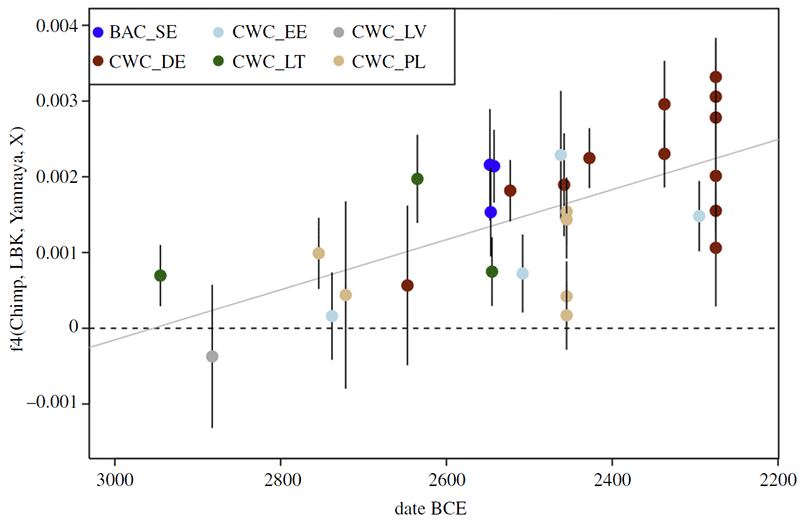
Radiocarbon dating showed that the three individuals from the Öllsjö megalithic tomb derived from later burials, where oll007 (2860–2500 cal BCE) overlaps with the time interval of the BAC, and oll009 and oll010 (1930–1650 cal BCE) fall within the Scandinavian Late Neolithic and Early Bronze Age
For more on how the Pitted Ware culture may have influenced Uralic-speaking Battle Axe peoples earlier than Indo-European-speaking Bell Beakers in Scandinavia, read more about Early Bronze Age Scandinavia and about the emergence of the Pre-Proto-Germanic community.
II. Bell Beakers through the Bronze Age
New paper (behind paywall) Kinship-based social inequality in Bronze Age Europe, by Mittnik et al. Science (2019).
II.1. Yamnaya vanguard settlers
In my last post, I showed how the ancestry of Corded Ware from Esperstedt is consistent with influence by incoming Yamnaya vanguard settlers or early Bell Beakers, stemming ultimately from the Carpathian Basin, something that could be inferred from the position of the Esperstedt outlier in the PCA, and by the knowledge of Yamnaya archaeological influences up to Saxony-Anhalt.
Yamnaya settlers are strongly suspected to have migrated in small so-called vanguard groups to the west and north of the Carpathians in the first half of the 3rd millennium BC, well before the eventual adoption of the Proto-Beaker package and their expansion ca. 2500 BC as East Bell Beakers.
Tauber Valley infiltration
As I mentioned in the books, one of the known – among the many more unknown – sites displaying Yamnaya-related traits and suggesting the expansion of Yamnaya settlers into Central Europe is Lauda-Königshofen, in the Tauber Valley.
From Diet and Mobility in the Corded Ware of Central Europe, by Sjögren, Price, & Kristiansen PLoS One (2017):
A series of CW cemeteries have been excavated in the Tauber valley. There are three large cemeteries known and some 30 smaller sites. The larger ones are Tauberbischofsheim-Dittingheim with 62 individuals, Tauberbischofsheim-Impfingen with 40 individuals, and Lauda-Königshofen with 91 individuals. The cemeteries are dispersed rather regularly along the Tauber valley, on both sides of the river, suggesting a quite densely settled landscape.
The Lauda-Königshofen graves consisted mostly of single inhumations in contracted position, usually oriented E-W or NE-SW. A total of 91 individuals were buried in 69 graves. At least 9 double graves and three graves with 3–4 individuals were present. In contrast to the common CW pattern, sexes were not distinguished by body position, only by grave goods. This trait is common in the Tauber valley and suggests a local burial tradition in this area. Stone axes were restricted to males, pottery to females, while other artifacts were common to both sexes. About a third of the graves were surrounded by ring ditches, suggesting palisade enclosures and possibly over-plowed barrows.
In particular, Frînculeasa, Preda, & Heyd (2015) used Lauda-Königshofen as representative of the mobility of horse-riding Yamnaya nomadic herders migrating into southern Germany, referring to the findings in Trautmann (2012) about the nomadic herders from the Tauber Valley, and their already known differences with other Corded Ware groups.
The likely influence of Yamnaya in the region has been reported at least since the 2000s, repeatedly mentioned by Jozef Bátora (2002, 2003, 2006), who compiled Yamnaya influences in a map that has been copied ever since, with little improvement over time. Heyd believes that there are potentially many Yamnaya remains along the Middle and Lower Danube and tributaries not yet found, though.
NOTE. Looking for this specific site, I realized that Bátora (and possibly many after him who, like me, copied his map) located Lauda-Königshofen in a more south-western position within Baden-Württemberg than its actual location. I have now corrected it in the maps of Chalcolithic migrations.

Althäuser Hockergrab…Bell Beakers
Unfortunately, though, it is very difficult to attribute the reported R1b-L51 sample from the Tauber valley to a population preceding the arrival of East Bell Beakers in the region, so there is no uncontroversial smoking gun of Yamnaya vanguard settlers – yet. Reasons to doubt a Pre-Beaker origin are as follows:
1. This family of the Tauber valley shows a late radiocarbon date (ca. 2500 BC), i.e. from a time where East Bell Beakers are known to have been already expanding in all directions from the Middle and Upper Danube and its tributaries.
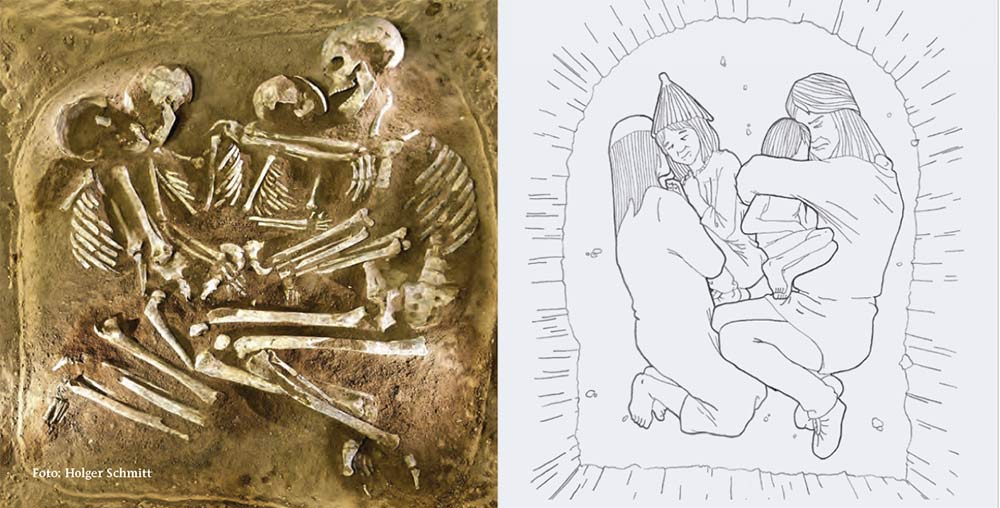
2. Archaeological information is scarce. Remains of these four individuals were discovered in 1939 and officially reported together with other findings in 1950, without any meaningful data that could distinguish between Bell Beakers and Corded Ware individuals.
This site is located in the Tauber valley, ca. 100 km to the northwest of the Lech valley. The site was discovered during the construction of a sports field in 1939 and was subsequently excavated by G. Müller and O. Paret. Four individuals in crouched position were found in the burial pit of a flat grave. The burial did not contain any grave goods, but due to the type of grave and positioning of the bodies (with heads pointing towards southwest) the site was attributed to the Corded Ware complex.
The classification of this burial as of CWC and not BBC seems to have been based entirely on the numerous CWC findings in the Tauber valley, rather than on its particular burial orientation following a regional custom (foreign to the described standard of both cultures), and on its grave type that was also found among Bell Beaker groups. Like many human remains recovered in dubious circumstances in the 20th century, these samples should have probably been labelled (at least in the genetic paper) more properly as Tauber_LN or Tauber_EBA.

3. In terms of ancestry, there seem to be no gross differences between the Lech Valley BBC individuals and previously reported South German Beakers, originally Yamnaya-like settlers admixing through exogamy with locals, including Corded Ware peoples, as the sex bias of the Lech Valley Beakers proves (see PCA plot below). In other words, northern and eastern Beakers admixed with regional (Epi-)Corded Ware females during their respective expansions, similar to how southern and western Beakers admixed with regional EEF-related females.
The two available Tauber Valley samples (“Tauber_CWC”) show the same pattern: a quite recent Steppe-related male bias and Anatolia_Neolithic-related female bias. Nevertheless, the male sample clusters ‘to the south’ in the PCA relative to all sampled Corded Ware individuals (see PCA plot below), and shows less Yamnaya-like ancestry than what is reported (or can be inferred) for Yamnaya from Hungary or early Bell Beakers of elevated Steppe-related ancestry.

The ancestry and position of the Althäuser male in the PCA is thus fully compatible with recently incoming East Bell Beakers admixing with local peoples (including Corded Ware) through exogamy, but not so much with a sample that would be expected from Yamanaya vanguard + Corded Ware-related ancestry (more like the Esperstedt outlier or the early France Beaker). Compared to the more ‘northern’ (fully Corded Ware-like) position ancestry of his female counterpart, there is little to support that both are part of the same native Tauber valley community after generations of ancestry levelling…
#UPDATE (27 OCT 2019): The PCA shows that the Althäuser male clusters, in fact, ‘to the north’ of the female one, almost on the same spot as a Bell Beaker sample from the Lech Valley.
Despite their reported damage and poor coverage, there seems to be a trend for qpAdm values to prefer a source population for the male (Alt_4) close to Germany Beakers, whereas the female sample (Alt_3) shows ‘better’ fits when a Corded Ware source is selected.
Also relevant is the Corded Ware ancestry of the male – closer to a Czech rather than German CWC source – compatible with an eastern origin, hence supporting a recent arrival via the Danube, in contrast to the local source of the CWC admixture of the female. The poorer coverage of the female sample makes these results questionable, though.
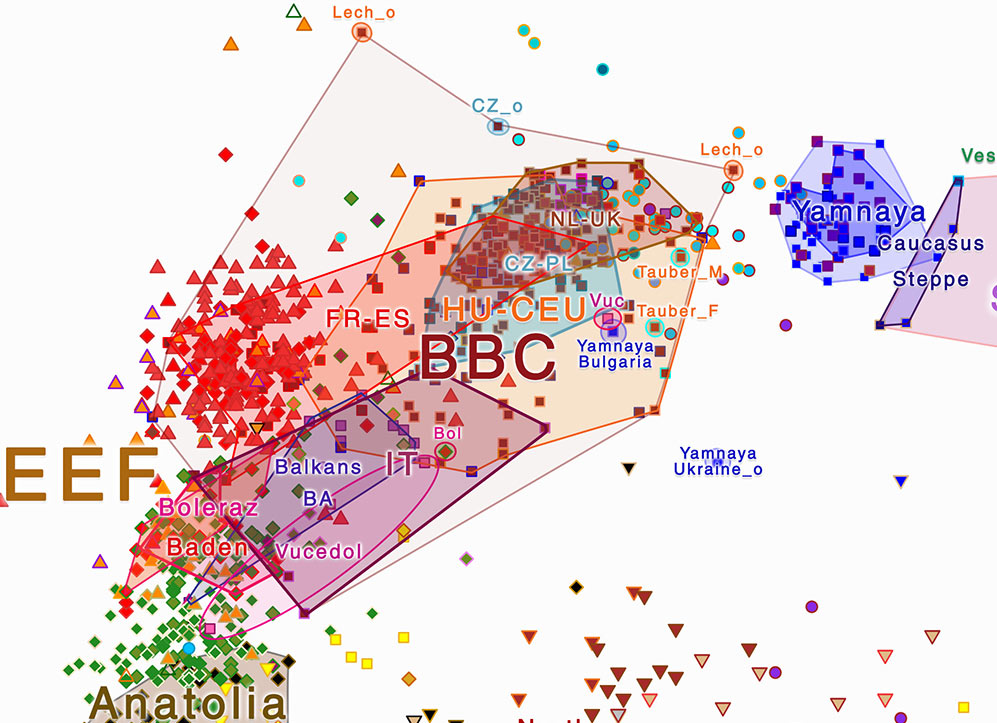
4. The haplogroup inference is also unrevealing: whereas the paper reports that it is R1b-P310* (xU106, xP312), there is no data to support a xP312 call, so it may well be even within the P312 branch, like most sampled Bell Beaker males. Similarly, the paper also reports that HUGO_180Sk1 (ca. 2340 BC) shows a positive SNP for the U106 trunk, which would make it the earliest known U106 sample and originally from Central Europe, but there is no clear support for this SNP call, either. At least not in their downloadable BAM files, as far as I can tell. Even if both were true, they would merely confirm the path of expansion of Yamnaya / East Bell Beakers through the Danube, already visible in confirmed genomic data:

II.2. Proto-Celts and the Tumulus culture
The most interesting data from Mittnik et al. (2019) – overshadowed by the (at first sight) striking “CWC” label of the Althäuser male – is the finding that the most likely (Pre-)Proto-Celtic community of Southern Germany shows, as expected, major genetic continuity over time with Yamnaya/East Bell Beaker-derived patrilineal families, which suggests an almost full replacement of other Y-chromosome haplogroups in Southern German Bronze Age communities, too.
Sampled families form part of an evolving Bell Beaker-derived European BA cluster in common with other Indo-European-speaking cultures from Western, Southern, and Northern Europe, also including early Balto-Slavs, clearly distinct from the Corded Ware-related clusters surviving in the Eastern Baltic and the forest zone.
This Central European Bronze Age continuity is particularly visible in many generations of different patrilocal families practising female exogamy, showing patrilineal inheritance mainly under R1b-P312 (mostly U152+) lineages proper of Central European bottlenecks, all of them apparently following a similar sociopolitical system spanning roughly a thousand years, since the arrival of East Bell Beakers in the region (ca. 2500 BC) until – at least – the end of the Middle Bronze Age (ca. 1300 BC):
Here, we show a different kind of social inequality in prehistory, i.e., complex households that consisted of i) a higher-status core family, passing on wealth and status to descendants, ii) unrelated, wealthy and high-status non-local women and iii) local, low-status individuals. Based on comparisons of grave goods, several of the high-status non-local females could have come from areas inhabited by the Unetice culture, i.e., from a distance of at least 350 km. As the EBA evidence from most of Southern Germany is very similar to the Lech valley, we suggest that social structures comparable to our microregion existed in a much broader area. The EBA households in the Lech valley, however, seem similar to the later historically known oikos, the household sphere of classic Greece, as well as the Roman familia, both comprising the kin-related family and their slaves.

NOTE. For those unfamiliar with the usual clusters formed by the different populations in the PCA, you can check similar graphics: PCA with Bell Beaker communities, PCA with Yamnaya settlers from the Carpathians, a similar one from Wang et al. (2019) showing the Yamnaya-Hungary cline, or the chronological PCAs prepared by me for the books.
The gradual increase in local EEF-like ancestry among South Germany EBA and MBA communities over the previous BBC period offers a reasonable explanation as to how Italic and Celtic communities remained in loose contact (enough to share certain innovations) despite their physical separation by the Alps during the Early Bronze Age, and probably why sampled Bell Beakers from France were found to be the closest source of Celts arriving in Iberia during the Urnfield period.
Furthermore, continued contacts with Únětice-related peoples through exogamy also show how Celtic-speaking communities closer to the Danube might have influenced (and might have been influenced by) Germanic-speaking communities of the Nordic Late Neolithic and Bronze Age, helping explain their potentially long-lasting linguistic exchange.
Like other previous Neolithic or Chalcolithic groups that Yamnaya and Bell Beakers encountered in Europe, ancestry related to the Corded Ware culture became part of Bell Beaker groups during their expansion and later during the ancestry levelling in the European Early Bronze Age, which helps us distinguish the evolution of Indo-European-speaking communities in Europe, and suggests likely contacts between different cultural groups separated hundreds of km. from each other.
All in all, there is nothing to support that (epi-)Corded Ware groups might have survived in any way in Central or Western Europe: whether through their culture, their Y-chromosome haplogroups, or their ancestry, they followed the fate of other rapidly expanding groups before them, viz. Funnelbeaker, Baden, or Globular Amphorae cultural groups. This is very much unlike the West Uralic-speaking territory in the Eastern Baltic and the Russian forests, where Corded Ware-related cultures thrived during the Bronze Age.
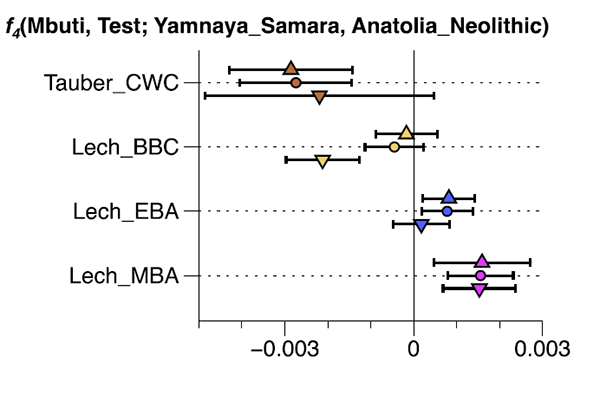
Conclusion
It was about time that geneticists caught up with the relevance of Y-DNA bottlenecks when assessing migrations and cultural developments.
From Malmström et al. (2019):
The paternal lineages found in the BAC/CWC individuals remain enigmatic. The majority of individuals from CWC contexts that have been genetically investigated this far for the Y-chromosome belong to Y-haplogroup R1a, while the majority of sequenced individuals of the presumed source population of Yamnaya steppe herders belong to R1b. R1a has been found in Mesolithic and Neolithic Ukraine. This opens the possibility that the Yamnaya and CWC complexes may have been structured in terms of paternal lineages—possibly due to patrilineal inheritance systems in the societies — and that genetic studies have not yet targeted the direct sources of the expansions into central and northern Europe.
From Gibbons (2019), a commentary to Mittnik et al. (2019):
Some of the early farmers studied were part of the Neolithic Bell Beaker culture, named for the shape of their pots. Later generations of Bronze Age men who retained Bell Beaker DNA were high-ranking, buried with bronze and copper daggers, axes, and chisels. Those men carried a Y chromosome variant that is still common today in Europe. In contrast, low-ranking men without grave goods had different Y chromosomes, showing a different ancestry on their fathers’ side, and suggesting that men with Bell Beaker ancestry were richer and had more sons, whose genes persist to the present.
There was no sign of these women’s daughters in the burials, suggesting they, too, were sent away for marriage, in a pattern that persisted for 700 years. The only local women were girls from high-status families who died before ages 15 to 17, and poor, unrelated women without grave goods, probably servants, Mittnik says. Strontium levels from three men, in contrast, showed that although they had left the valley as teens, they returned as adults.
Also, from Scientific American:
(…) it has long been assumed that prior to the Athenian and Roman empires,—which arose nearly 2,500 and more than 2,000 years ago, respectively—human social structure was relatively straightforward: you had those who were in power and those who were not. A study published Thursday in Science suggests it was not that simple. As far back as 4,000 years ago, at the beginning of the Bronze Age and long before Julius Caesar presided over the Forum, human families of varying status levels had quite intimate relationships. Elites lived together with those of lower social classes and women who migrated in from outside communities. It appears early human societies operated in a complex, class-based system that propagated through generations.
It seems wrong (to me, at least) that the author and – as he believes – archaeologists and historians had “assumed” a different social system for the European Bronze Age, which means they hadn’t read about how Indo-European societies were structured. For example, long ago Benveniste (1969) already drew some coherent picture of these prehistoric peoples based on their reconstructed language alone: regarding their patrilocal and patrilineal family system; regarding their customs of female exogamy and marriage system; and regarding the status of foreigners and slaves as movable property in their society.
A long-lasting and pervasive social system of Bronze Age elites under Yamnaya lineages strikingly similar to this Southern German region can be easily assumed for the British Isles and Iberia, and it is likely to be also found in the Low Countries, Northern Germany, Denmark, Italy, France, Bohemia and Moravia, etc., but also (with some nuances) in Southern Scandinavia and Central-East Europe during the Bronze Age.
Therefore, only the modern genetic pool of some border North-West Indo-European-speaking communities of Europe need further information to describe a precise chain of events before their eventual expansion in more recent times:
- the relative geographical isolation causing the visible regional founder effects in Scandinavia, proper of the maritime dominion of the Nordic Late Neolithic (related thus to the Island Biogeography Theory); and
- the situation of the (Pre-)Proto-Balto-Slavic community close to the Western Baltic which, I imagine, will be shown to be related to a resurge of local lineages, possibly due to a shift of power structures similar to the case described for Babia Góra.
NOTE. Rumour has it that R1b-L23 lineages have already been found among Mycenaeans, while they haven’t been found among sampled early West European Corded Ware groups, so the westward expansion of Indo-European-speaking Yamnaya-derived peoples mainly with R1b-L23 lineages through the Danube Basin merely lacks official confirmation.
Related
- Bell Beakers and Mycenaeans from Yamnaya; Corded Ware from the forest steppe
- On the Ukraine Eneolithic outlier I6561 from Alexandria
- Yamnaya replaced Europeans, but admixed heavily as they spread to Asia
- Corded Ware culture origins: The Final Frontier
- Volga Basin R1b-rich Proto-Indo-Europeans of (Pre-)Yamnaya ancestry
- A very “Yamnaya-like” East Bell Beaker from France, probably R1b-L151
- Yamnaya ancestry: mapping the Proto-Indo-European expansions
- Aquitanians and Iberians of haplogroup R1b are exactly like Indo-Iranians and Balto-Slavs of haplogroup R1a
- The genetic and cultural barrier of the Pontic-Caspian steppe – forest-steppe ecotone
- On the origin of haplogroup R1b-L51 in late Repin / early Yamna settlers
- On the origin and spread of haplogroup R1a-Z645 from eastern Europe